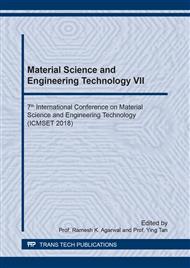p.128
p.133
p.138
p.144
p.149
p.154
p.160
p.165
p.170
Synthesis of Silver-Doped Titanium Dioxide Nanotubes by Single-Step Anodization for Enhanced Photodegradation of Acid Orange 52
Abstract:
Silver-doped TiO2 nanotubes (Ag-TiNTs) were synthesized in a top-down approach by single-step anodization of titanium sheets. The highly-ordered array of Ag-TiNTs was confirmed by scanning electron microscopy with an average inner diameter of 41.28 nm and a wall thickness of 35.38 nm. Infrared spectroscopy confirmed the presence of O-Ti-O bonds. Analysis of the X-ray powder diffraction profiles showed the characteristic peaks for anatase and titanium for both pristine TiNTs and Ag-TiNTs. Ag-doping caused no observed changes in the crystalline structure of pristine TiNTs. High-definition X-ray fluorescence spectroscopy revealed that the synthesized Ag-TiNTs have 0.05 wt% Ag-loading. Even at low Ag-loading, the Ag-TiNTs were shown to be photo-active, achieving 10.13% degradation of Acid Orange 52 under UV illumination after 120 min.
Info:
Periodical:
Pages:
149-153
Citation:
Online since:
April 2019
Authors:
Keywords:
Price:
Сopyright:
© 2019 Trans Tech Publications Ltd. All Rights Reserved
Share:
Citation:


